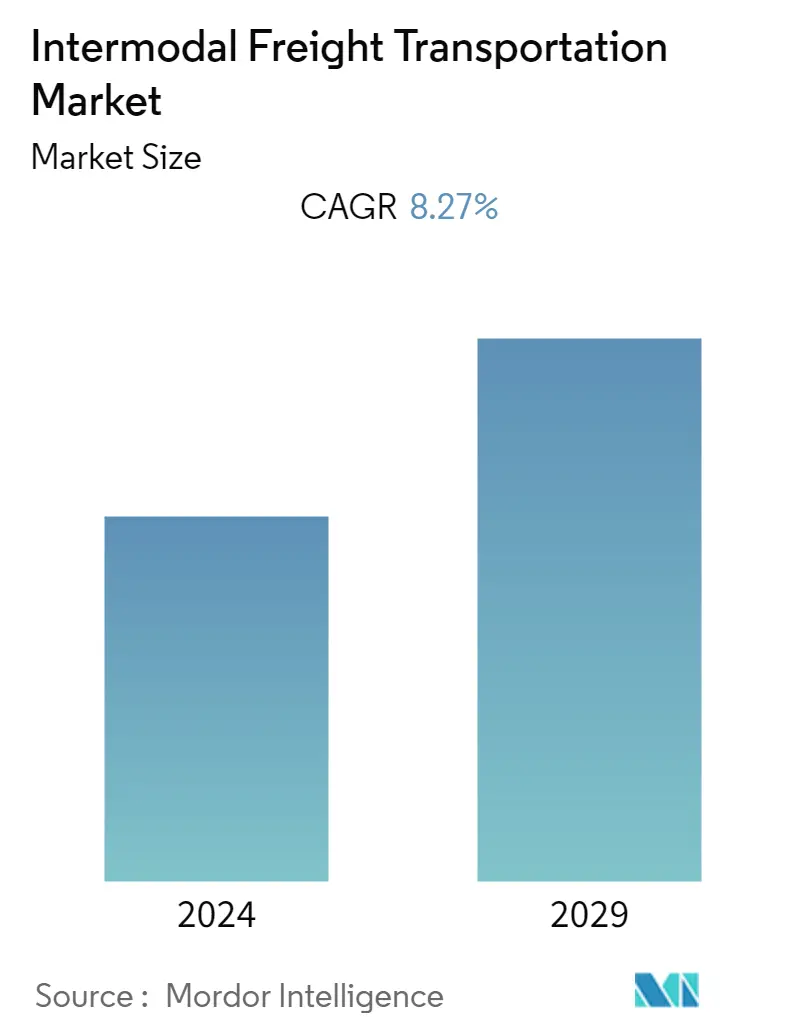Market Size of Intermodal Freight Transportation Industry

| Study Period | 2019 - 2029 |
| Base Year For Estimation | 2023 |
| CAGR | 8.27 % |
| Fastest Growing Market | Asia-Pacific |
| Largest Market | North America |
| Market Concentration | Medium |
Major Players
*Disclaimer: Major Players sorted in no particular order |
Need a report that reflects how COVID-19 has impacted this market and its growth?
Intermodal Freight Transportation Market Analysis
Intermodal Freight Transportation Market is anticipated to register a CAGR of 8.27% during the forecast period. When moving long distances, companies should consider alternate transportation modes as they evaluate emerging ways to cut freight costs and their carbon footprint. Although trucking remains the most common means of domestic product shipment, intermodal freight transit offers freight savings and decreased emissions, particularly when delivering items over 500 miles or more. Intermodal can assist in reducing cargo handling, damage, and loss by optimizing each transport method's strengths and efficiency, allowing freight to be moved more safely and at a lower aggregate cost.
- Transportation accounts for 66% of overall logistics expenses, according to the Council of Supply Chain Management Professionals' State of Logistics Report. Management of the transportation network proactively may prevent these costs from rising as trucking issues such as driver shortages and productivity-stifling trucking rules limit capacity in the coming years. Intermodal may be a strong option if the company wants to reduce supply chain interruption, manage supply risk, and lower transportation expenses. Including multimodal transportation in the transportation mix results in significant cost reductions. By incorporating several means of transportation into the carrier base, the reliance on a single source of capacity is reduced. Supply chain leaders that use multimodal freight moves may gain in the short and long term by utilizing the capabilities of each mode of transportation.
- Moreover, the U.S. Environmental Protection Agency (EPA) reports that using intermodal transport for shipments over 1,000 miles can cut fuel use and greenhouse gas emissions by as much as 65% relative to truck transport alone. A truck that can transport 40,000 lbs from Los Angeles to Boston produces approximately 4.35 tons of carbon emissions. The same 40,000 pounds, which could be shipped via intermodal rail, produces 1.75 tons of carbon emissions, significantly less. Intermodal transportation can effectively help reduce a company's carbon footprint. The EPA estimates that every ton-mile of freight moved by rail instead of highway can reduce greenhouse emissions by two-thirds. This is essential as companies continually work to reduce their carbon footprint to comply with environmental regulations and meet their corporate sustainability goals.
- Extensive intermodal rail facilities are challenged by high truck volume and often serve the trucks in the order they arrive at a crane, which is not optimal. Efficiencies can be gained by calling the trucks to the crane to match the containers' stacking order rather than shuffling boxes to serve the trucks on a first-come, first-served basis. This makes the trucker with transactions significantly reduce the need to contact the terminal, helping terminals capture billable processes and events. Items such as checking whether a waybill is in place well before a trucker's arrival at the gate could be managed with the help of a mobile software application. This capability could help drivers perform advanced check-in and check-out, complete service requests, confirm unit locations, and receive parking location updates from a mobile phone.
- During the COVID-19 pandemic, the government globally restricted its borders to non-citizens and non-residents or imposed on those entering extended periods of self-isolation to limit the spread of the virus while implementing lockdowns, strict social distancing, and contact tracing measures. These often-excessive restrictions to cross-border and transit freight transport further aggravated the economic and social impacts of the pandemic shock on the global economy.
- The market is witnessing significant mergers and acquisitions by multiple companies to increase its presence. In June last year, Generix Group, a global provider of collaborative SaaS Software solutions for the Supply Chain, industrial, and retail ecosystems, assisted Jacquet Brossard, a Limagrain Group company and a major player in the food industry, in the transformation of its transport and supply operations through the SaaS implementation of Generix TMS and GCR (Generix Collaborative Replenishment) solutions.
